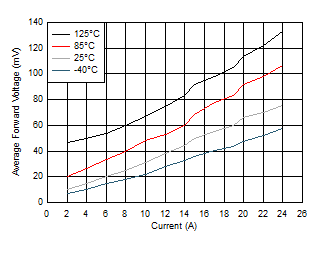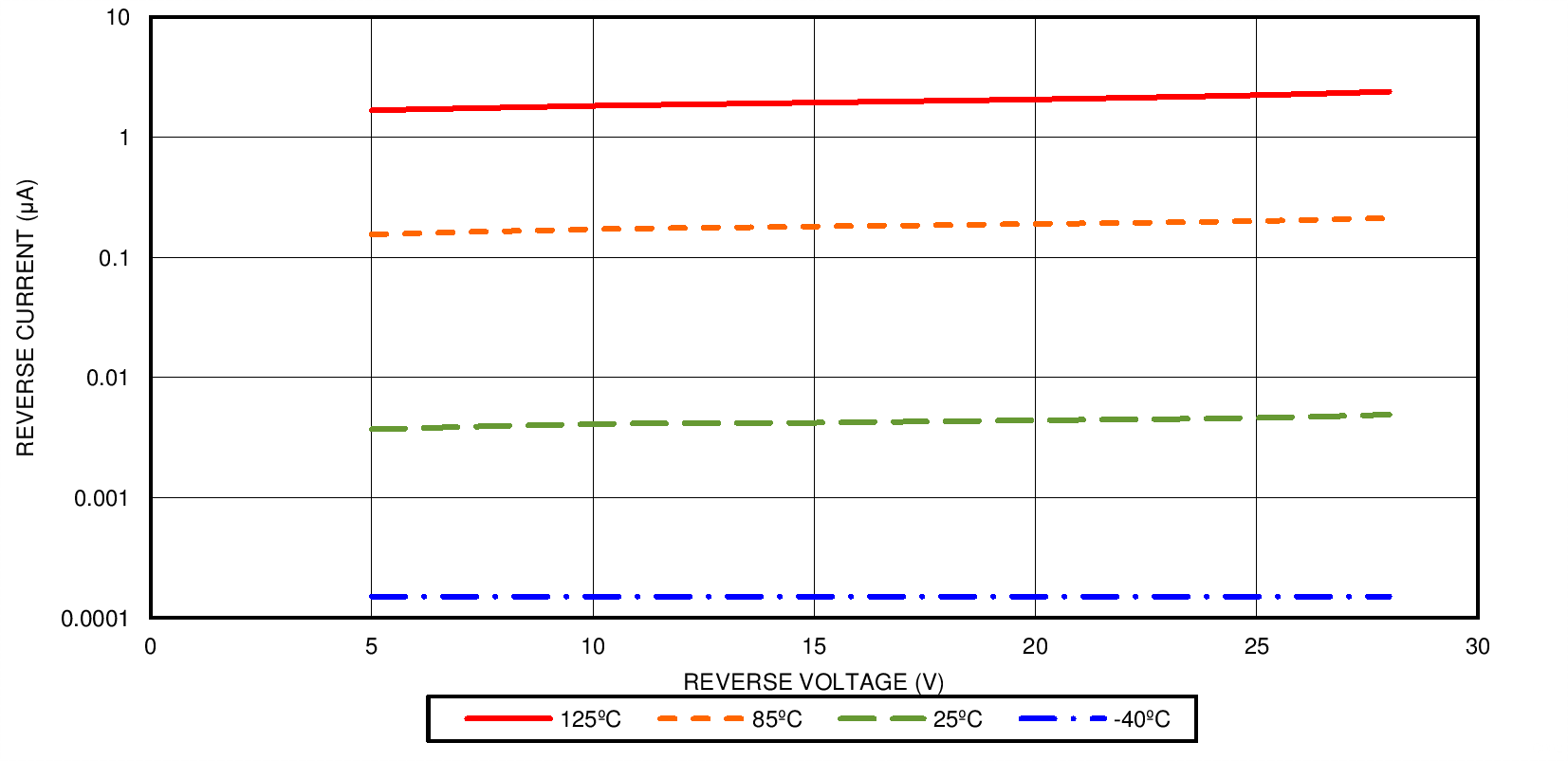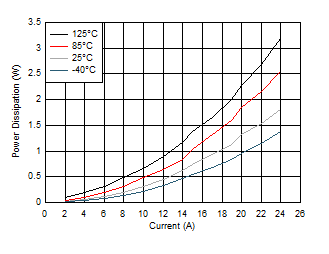ZHCSDI7A December 2012 – March 2015 SM74611
PRODUCTION DATA.
6 Specifications
6.1 Absolute Maximum Ratings
over operating free-air temperature range (unless otherwise noted) (1)(2)| MIN | MAX | UNIT | |
|---|---|---|---|
| Ambient Storage temperature, Tstg | -65 | 125 | °C |
| DC Reverse Voltage | 30 | V | |
| Forward Current | 24 | A | |
| Junction Temperature, t ≤ 1 hour | 135 | °C |
(1) Stresses beyond those listed under Absolute Maximum Ratings may cause permanent damage to the device. These are stress ratings only, which do not imply functional operation of the device at these or any other conditions beyond those indicated under Recommended Operating Conditions. Exposure to absolute-maximum-rated conditions for extended periods may affect device reliability.
(2) System must be thermally managed so as not to exceed maximum junction temperature
6.2 ESD Ratings
| VALUE | UNIT | |||
|---|---|---|---|---|
| V(ESD) | Electrostatic discharge | Human-body model (HBM), per ANSI/ESDA/JEDEC JS-001(1) | ±1000 | V |
| Charged-device model (CDM), per JEDEC specification JESD22-C101(2) | ±250 | |||
(1) JEDEC document JEP155 states that 500-V HBM allows safe manufacturing with a standard ESD control process. Pins listed as ±XXX V may actually have higher performance.
(2) JEDEC document JEP157 states that 250-V CDM allows safe manufacturing with a standard ESD control process. Pins listed as ±YYY V may actually have higher performance.
6.3 Recommended Operating Conditions(1)
over operating free-air temperature range (unless otherwise noted)| MIN | NOM | MAX | UNIT | ||
|---|---|---|---|---|---|
| DC Reverse Voltage | 28 | V | |||
| Junction Temperature Range (TJ) | -40 | 125 | °C | ||
| Forward Current | 0 | 15 | A | ||
(1) System must be thermally managed so as not to exceed maximum junction temperature
6.4 Thermal Information
| THERMAL METRIC(1) | SM74611 | UNIT | |
|---|---|---|---|
| DDPAK (KTT) | |||
| 3 PINS | |||
| RθJA | Junction-to-ambient thermal resistance | 40.4 | °C/W |
| RθJC(top) | Junction-to-case (top) thermal resistance | 42.6 | |
| RθJB | Junction-to-board thermal resistance | 23.0 | |
| ψJT | Junction-to-top characterization parameter | 9.8 | |
| ψJB | Junction-to-board characterization parameter | 22.0 | |
| RθJC(bot) | Junction-to-case (bottom) thermal resistance | 0.5 | |
(1) For more information about traditional and new thermal metrics, see the IC Package Thermal Metrics application report, SPRA953.
6.5 Electrical Characteristics
| PARAMETER | TEST CONDITIONS | MIN | TYP | MAX | UNIT | ||||
|---|---|---|---|---|---|---|---|---|---|
| IF(AVG) | Forward Current | 8 | 15 | A | |||||
| VF(AVG) | Forward Voltage | IF = 8A | TJ = 25°C | 26 | mV | ||||
| PD | Power Dissipation | IF = 8A | TJ = 25°C | 208 | mW | ||||
| TJ = 125°C | 450 | ||||||||
| -40°C to 125°C (1) | 575 | ||||||||
| IF = 15A | TJ = 25°C | 695 | |||||||
| TJ = 125°C | 1389 | ||||||||
| D | Duty Cycle | IF = 8A | TJ = 25°C | 99.5% | |||||
| TJ = 125°C | 96.0% | ||||||||
| IR | Reverse Leakage Current | VREVERSE = 28V | TJ = 25°C | 0.3 | µA | ||||
| TJ = 125°C | 3.3 | ||||||||
(1) Limits -40°C to 125°C apply over the entire junction temperature range for operation. Limits appearing in normal type apply for TA = TJ = 25°C.


